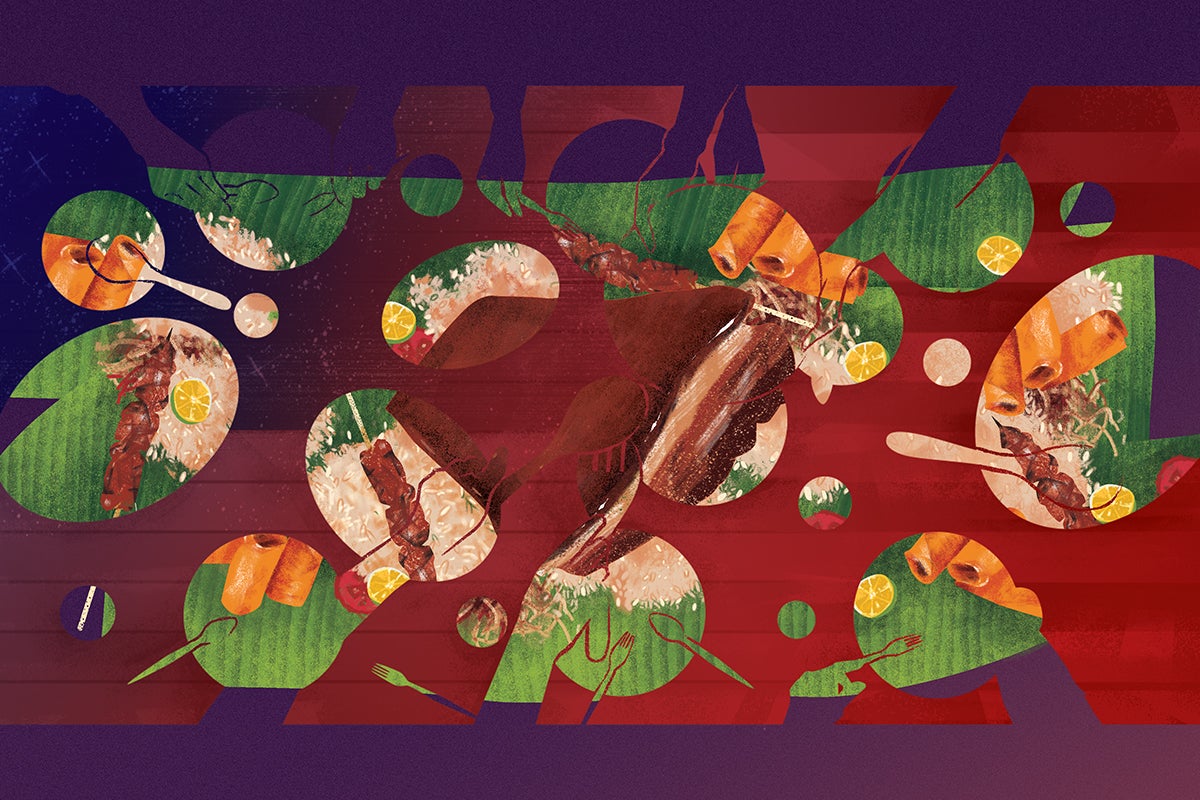
Holidays. Daily routines. Meeting someone new. Often, these occurrences are centered around something that’s core to humanity’s existence, from survival to luxury experiences: food.
Whether we share a love for a dish, or we’re divided over a delicacy, food has the power to shift relationships, families, societies and entire cultures. It’s a marker of history, political relations, economic status, social norms and cultural identity. As the adage says, “You are what you eat.”
“One of the reasons I get excited about food as an anthropologist is because it’s something that everybody can relate to,” says Professor Ty Matejowsky. “It’s something that you don’t need to have a highly defined appreciation of the arts or a deep literacy [to appreciate] — anybody can enjoy a good meal. Food is one of the most resonant and … powerful modes of expressing a culture.”
Influences on Identity
Although the word “fusion” wasn’t applied in restaurant contexts until the 1980s, mixing cuisines has long been a global practice. For Matejowsky, the Philippines is a great example of a country’s cuisine that holds a distinct cultural identity that’s also been shaped by external regions. For over three decades he’s studied and traveled there, walking a line between academic and tourist, often examining the Philippines through its food.
“The Philippines is really a fascinating place because it bridges the gap between the West and the East.”
“The Philippines is really a fascinating place because it bridges the gap between the West and the East,” Matejowsky says. “It’s fundamentally an Asian country, but there are a lot of European and American influences that still are encountered there. It’s [one of the top] English-speaking countries in the world. It was a colony of Spain for almost 400 years. And then after the Spanish-American War, it came under American influence.”
From the names of dishes like adobo (slow-roasted meat in vinegar sauce), chicharron (fried pork rinds) and lechon (roast pig), Spanish influence on Filipino food is easy to see. Other signature dishes, like lumpia (fried spring rolls) and pancit (stir-fried noodles), highlight China’s impact on Filipino food. Arroz caldo (a rice soup similar to Vietnamese congee that’s served with chicken) is technically an Asian and Spanish combo that’s a Filipino signature.
When it comes to American influence on the Philippines, there is one product that remains paramount — Spam. Created in 1937 as a cheap, nonperishable versatile pork product, Spam spread throughout regions of U.S. military occupation following World War II, such as Hawaii, Korea, Japan, many of the Pacific Islands and the Philippines, Matejowsky says.
“What’s really interesting about Spam is in the United States many people look down on it as either a poor person’s food or something people who don’t have a sophisticated palate would like,” Matejowsky says. “But in the Asia-Pacific, it’s considered something of a delicacy; it’s considered more high-end. It’s the same product, but yet it’s viewed almost 180 degrees differently in [the East and the West].”
Perception of foods across cultures has, and will always, vary — even as the world has become more globalized. One of the Philippine’s most iconic dishes, like many other delicacies, is loved by some and hated by other: balut. The fertilized duck egg has a unique taste that when consumed completes a rite of passage for Filipinos. Or in the case of visitors, like Matejowsky, eating balut can mark acceptance and appreciation for the region’s culture.
“For Filipinos, it’s a cultural signifier, it marks identity,” Matejowsky says.
Maintaining cultural identity can become even more important when people emigrate from their native region. For Filipino immigrants, there is a quick and convenient way to get a taste of home that is growing worldwide — the fast-food chain Jollibee. Founded in 1978 as a local brand, Jollibee began modeling itself after the world’s No. 1 fast-food chain when McDonald’s was introduced to the Philippines in 1981, Matejowsky says. But by offering Filipino fare, such as a spaghetti dish made with banana ketchup, which is popular in the region, and palabok, a traditional noodle dish, in addition to American fast-food items, like burgers and fried chicken, Jollibee became more popular than McDonald’s in the Philippines. There are now more than 600 McDonald’s and nearly 1,200 Jollibees in the region. Matejowsky compares the Jollibee and McDonald’s rivalry in the Philippines to the story of David and Goliath, with a local upstart beating a global giant.
“By consuming certain foods, like Jollibee Yumburgers — or even canned Spam — it acts like a small reminder of home for migrants thousands of miles away.”
“The fact that the Philippines used to be under colonial rule of America, there’s this undercurrent of postcolonial resistance whereby they’re beating Americans at their own game,” Matejowsky says. “So it’s a source of pride for many Filipinos. And by consuming certain foods, like Jollibee Yumburgers — or even canned Spam — it acts like a small reminder of home for migrants thousands of miles away,” he says.
Adapting Through Ingredients
Marshall University Assistant Professor of Sociology Boniface Noyongoyo ’18PhD has built his career on understanding how culture and society influences eating habits. Growing up in Cameroon, he says he was immersed in a multicultural environment. When he moved to the U.S. to pursue his master’s degree at East Carolina University in Greenville, North Carolina, his experience as an international student inspired him to explore this field. He saw firsthand how food can tie you to a region — both ones you’re familiar with and ones you’re discovering.
Even community with one other person can help reinforce connections to food.
As a sociology doctoral student at UCF, Noyongoyo continued exploring food and culture. His findings reinforce the influence of factors we all deal with daily — reduced access to specialty food items and higher prices for those ingredients along with time constraints — that cause international students to be less inclined to cook traditional meals. After about six months in the U.S. international students are more likely to adapt to a typical American diet, which often consists of processed foods and convenient restaurant meals.

Noyongoyo also found that African students are more likely to adapt American eating habits than other international students. Part of this is likely related to the underrepresentation of African cuisine throughout the United States.
“I moved to West Virginia for my position at Marshall University … the closest [African] store is two hours away,” Noyongoyo says. “So … I travel sometimes. I met faculty on campus from Nigeria and Congo and … we found ways for buying food in different places that have flavors from different parts of the continent. … I can acknowledge how helpful it is to have a community.”
Even community with one other person can help reinforce connections to food, as Noyongoyo also found that married international students who came to America were more likely to eat their traditional cuisine. And personally, he experienced how having a few people invested in his transition to the U.S. helped him stay connected to his roots.

“I was lucky to have [a host] family [when I moved to North Carolina],” he says. “My brother in that family has been to Cameroon, so he prepared his parents to the fact that I could need things they had not actually heard of before. When I got here, my host mom helped me a lot. We looked for African stores or those that sell items like yam, dried fish and vegetables like frozen cassava, for instance. The closest [store] was half an hour away and managed by a Sierra Leonean. Everything was expensive.”
Throughout history, immigrants have always adapted the ingredients available — sometimes creating dishes that have become synonymous with their cultures. Spaghetti and meatballs is considered by some to be an Italian classic, but it’s actually an Italian American invention. Italian immigrants created the dish to utilize the variety of items they had access to and to appeal to American diners by providing a hearty meal, according to the The Washington Post. The California roll is many people’s introduction to sushi. However, it is a riff off the traditional Japanese maki roll — placing the nori or seaweed sheet inside and adding king crab (later using imitation crab) and avocados to mimic some of the classic bites of sushi with ingredients that may appeal to Americans.
“Anyone can mix ingredients that feed the body and put the soul at ease [when they have] the urge for something from home,” Noyongoyo says. “Life does not stop because what we grew up eating cannot be found where one lives.”
Nowadays you can often find Noyongoyo in his home garden, where the produce reflects American crops, including a new favorite, ramps — a seasonal spring plant that tastes like garlic and onion. In his kitchen, he’ll incorporate African spices like njangsa (a nutty spice), pebbe (similar to nutmeg) and ginger to create his own custom dishes.
“Some of my students are confused when I tell them I love ramps,” he says. “They’re like, ‘Are you not from Africa?’ I say, ‘Yeah, but now I’m [also] from here.’ I started growing my own food and learned to cook with a lot of American [ingredients], but I am still clinging onto what I would call traditional dishes. So it’s a journey.”

Growing Community
Food’s representation of culture starts long before a meal is served. It begins with farming, a profession the world depends on about 2 billion people for. From types of crops to farming methods, food production is also a major indicator of who we — and how we’ve evolved as societies.
For nearly 200,000 years our ancestors survived by hunting and gathering before farming got its start about 12,000 years ago. The shift to farming is speculated to have been caused by changes in climate, population density, technology and overhunting — all factors farmers nowadays must still adapt to.
“Daily life really connects to agriculture all the time, and I think that’s something that most people don’t easily relate to.”
“Daily life really connects to agriculture all the time, and I think that’s something that most people don’t easily relate to,” says Associate Professor of Anthropology John Walker. “We can learn a lot about who we are from how we grow our food.”
Eastern cultures are often considered to be tighter knit than those in Western societies, and studies suggest it may be related to farming practices. Nine out of 10 of the world’s top rice producers — which account for almost 85% of global rice production — are located in Asia, according to the World Economic Forum. One study examined the indicators of individualism and collectivism among people in China, the No. 1 producer of rice and wheat in the world. It found people from rice-growing regions had more interdependent and holistic cultural attributes than people from wheat-growing regions. But why?
Paddy rice, which is grown in southern China, requires large amounts of water and twice the effort to cultivate than wheat, which is grown in northern China and can survive on rainwater. Rice farmers must rely on neighbors to help them develop irrigation systems and produce their crops. The need to collaborate to accomplish labor-intensive work causes communities in southern China to be more connected. Although the study focused on cultural attitudes in China, it suggests this correlation can be applied more broadly to other regions — and that this impact has been felt throughout history. But finding connections from our cultural practices and perceptions in the past isn’t as easy for some regions as others. Walker has been working with UCF Assistant Professor of Anthropology Neil Duncan and researchers from the U.K.’s Northumbria University to study farming practices in a region in the Amazon that isn’t as well-documented. It is known as the Llanos de Mojos in northeastern Bolivia.
Food’s representation of culture starts long before a meal is served. It begins with farming.
“This region has one of the highest diversity of languages in the world, which reflects distinct ways of life and cultural heritage,” Walker says. “We know something about the last 3,000 to 4,000 years of, say Europe or the Mediterranean, but we don’t have some of that same information for the people here.”
Present-day Llanos de Mojos’ landscape is a flat wetland that is used for cattle ranching, but archaeologists have found remnants that indicate the land was once used for farming and fishing. They just didn’t know how far back these activities dated — until now.
By examining cores of earth, the team found remains of plant particles, wood-burning and single-cell alga dating intensive land management to 3,500 years ago rather than the previously thought 1,700 years. The finding counters the idea that natives in the Amazon didn’t practice large-scale farming or intentionally shape their lands until Europeans arrived in the late 1400s.
“There might be whole ways of life and kinds of food that people had in the past that aren’t clear how they connect up to today,” Walker says. “There are things we can improve in archaeology to get more information about the past. And the past is not a simple version of the present. Culture is not some monolithic thing that’s around for thousands of years and never changes; it’s being created all the time.”
As technology makes our world even more interconnected, taking time to understand what we’re consuming and where it comes from — from how it was grown to why it was prepared the way it was — can help build community. By sharing a meal, we may find across the differences in our cultures that we’re often driven by the same things.

















